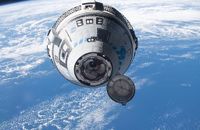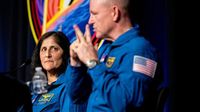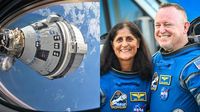NASA astronauts Sunita Williams and Barry Wilmore are eager to ride Boeing Space's Starliner capsule again despite their harrowing experience nine months ago. In a recent interview with Ars Technica, the duo revealed that the issues with Starliner were far more serious than people thought. Wilmore disclosed that after Starliner's thrusters failed, he lost control of the spacecraft just before docking at the International Space Station (ISS). The duo had launched to the ISS on June 7, 2024, but returned on March 19, 2025, in a SpaceX Dragon capsule, spending nine months instead of the planned eight days in space.
"Splashdown of Dragon confirmed – welcome back to Earth, Nick, Suni, Butch, and Aleks!" tweeted SpaceX on March 18, 2025, celebrating the safe return of the astronauts.
Wilmore had reportedly said that Starliner was within a stone's throw of the station, but the malfunctions made him consider returning to Earth. "I don't know that we can come back to Earth at that point. I don't know if we can. And matter of fact, I'm thinking we probably can't," he stated per Ars Technica.
The situation became dire when Starliner lost four of its 28 reaction control system thrusters while it was above the space station prior to docking. "The space station is nose down. So we’re not exactly level with the station, but below it. If you’re below the station, you’re moving faster. That’s orbital mechanics. It’s going to make you move away from the station," Wilmore explained.
The astronauts later contacted the team at NASA, and the engineers advised him to let go of the control so they could reset the thrusters. "Imagine that. You're drifting away from the space station, trying to maintain your position. The station is your only real lifeline because if you lose the ability to dock, the chance of coming back in one piece is quite low. And now you're being told to take your hands off the controls," said Williams, revealing that the incident made the two a bit nervous.
Touchdown of Starliner occurred on September 6, 2024, when the uncrewed spacecraft landed at New Mexico's White Sands Space Harbor at 12:01 am ET (0401 UTC). Despite the earlier troubles, the astronauts managed to dock at the ISS after three of the four failed thrusters came back online. "Entering the station made me super happy," Williams said, recalling her joy as she danced upon meeting the astronauts onboard.
On April 1, 2025, the duo addressed the media for the first time, detailing their mission which extended from eight days to nine months. Wilmore expressed his confidence in Starliner, stating he would get on it "in a heartbeat" as engineers are working to fix the problems with the spacecraft.
However, the issues with Starliner are not new. A 2020 NASA Aerospace Safety Advisory Panel report warned that "due to some fundamental [Systems Engineering and Integration] missteps" during earlier test flights, Starliner “not only did not meet the mission objectives, but it could have resulted in the loss of the vehicle.” The panel noted that Starliner encountered several software-driven problems that threatened its operation, resulting in 80 corrective actions.
As the Starliner approached the ISS on June 6, 2024, carrying Wilmore and Williams, the mission took a dangerous turn when two aft-facing reaction control system (RCS) thrusters failed. This put the crew in a precarious position, just one additional failure away from losing six-degrees-of-freedom (6DOF) control—the ability to maneuver in any direction. Standard flight rules dictated an abort under such conditions, but the situation rapidly deteriorated as a third and then a fourth thruster failed, severely impairing attitude control and eliminating the spacecraft’s ability to translate forward.
Faced with this dilemma—unable to safely dock or potentially return—NASA’s mission control made the critical decision to waive standard flight rules and attempt a remote recovery. Controllers in Houston instructed Wilmore to momentarily release manual control, announcing "hands off" before implementing a solution: remotely commanding resets of the thruster system. After two resets, enough thrusters recovered function to regain partial 6DOF control, enabling a successful, if tense, docking despite the compromised system.
This near-disaster occurred despite years of development and data from a previous uncrewed flight (OFT-2) in May 2022, which also experienced thruster anomalies, including failures during orbital insertion and docking approach. Furthermore, the CFT mission was plagued by five separate helium leaks discovered in Starliner’s service module propulsion system—one known before launch and four developing in flight—raising concerns about maintaining propellant pressure.
Post-flight analysis of the CFT thruster failures traced the immediate problem to overheating of small Teflon seal components within the thruster valves. Engineers believe repeated firing commands, particularly under manual control in direct sunlight, caused seals to deform and restrict propellant flow. While ground tests showed the seals could recover shape when cooled, this thermal vulnerability wasn’t adequately addressed during design and qualification.
The planned OFT-2 launch in August 2021 was scrubbed due to corroded oxidizer valves caused by unexpected moisture reacting with propellant—a flaw requiring a major redesign. Even in 2023, late-stage reviews uncovered flagging strength margins in parachute system components and fire risks from flammable tape on wiring harnesses, requiring laborious remediation. NASA had earlier identified "numerous process escapes" and noted that "breakdowns in the test and verification phase failed to identify… defects preflight." The June 2024 incidents suggest these systemic weaknesses may persist.
The combination of thruster unreliability and helium leaks during the CFT mission created so much uncertainty that NASA ultimately deemed the spacecraft too risky for the crew’s return journey. After weeks of analysis while Wilmore and Williams remained aboard the ISS, NASA decided in late summer 2024 that Starliner would return to Earth empty. The uncrewed capsule successfully landed at White Sands, New Mexico, on September 6, 2024. Wilmore and Williams saw their planned eight-day mission turn into a nearly nine-month extended stay. They eventually returned to Earth not aboard Starliner but via a SpaceX Crew Dragon spacecraft (Crew-9) on March 18, 2025. This marked the first time NASA astronauts launched on one type of American vehicle and returned on another.
NASA and Boeing are now engaged in a root cause investigation, analyzing data, inspecting hardware, and reviewing design, testing, and operations. Identifying and demonstrably fixing the root causes of the thruster failures and helium leaks is critical before Starliner can be certified for regular crew missions. This could potentially involve hardware redesigns, updated materials, modified procedures, or possibly another uncrewed test flight. The stakes are significant. Boeing has absorbed over $2 billion in cost overruns on its fixed-price Commercial Crew contract. Further delays or redesigns will add to this burden and impact the company’s reputation. For NASA, getting Starliner operational is crucial for redundant US crew access to the ISS. To date, the key R&D takeaways from Starliner’s journey is a reminder: complex system development demands relentless scrutiny and validation processes that accurately mirror the unforgiving reality of spaceflight.



